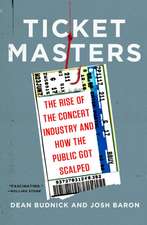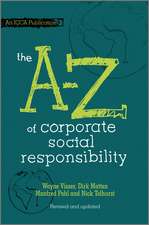Japanese Firms During the Lost Two Decades: The Recovery of Zombie Firms and Entrenchment of Reputable Firms: SpringerBriefs in Economics
Autor Jun-ichi Nakamuraen Limba Engleză Paperback – 10 aug 2016
Din seria SpringerBriefs in Economics
-
 Preț: 444.35 lei
Preț: 444.35 lei -
 Preț: 264.79 lei
Preț: 264.79 lei - 15%
 Preț: 462.51 lei
Preț: 462.51 lei -
 Preț: 47.33 lei
Preț: 47.33 lei -
 Preț: 353.14 lei
Preț: 353.14 lei -
 Preț: 273.32 lei
Preț: 273.32 lei -
 Preț: 376.04 lei
Preț: 376.04 lei -
 Preț: 379.09 lei
Preț: 379.09 lei -
 Preț: 380.07 lei
Preț: 380.07 lei -
 Preț: 377.35 lei
Preț: 377.35 lei -
 Preț: 379.09 lei
Preț: 379.09 lei -
 Preț: 376.59 lei
Preț: 376.59 lei -
 Preț: 408.27 lei
Preț: 408.27 lei -
 Preț: 379.09 lei
Preț: 379.09 lei -
 Preț: 383.28 lei
Preț: 383.28 lei -
 Preț: 378.54 lei
Preț: 378.54 lei -
 Preț: 377.95 lei
Preț: 377.95 lei -
 Preț: 340.23 lei
Preț: 340.23 lei -
 Preț: 380.25 lei
Preț: 380.25 lei -
 Preț: 378.12 lei
Preț: 378.12 lei -
 Preț: 376.04 lei
Preț: 376.04 lei -
 Preț: 376.04 lei
Preț: 376.04 lei -
 Preț: 379.68 lei
Preț: 379.68 lei -
 Preț: 381.00 lei
Preț: 381.00 lei -
 Preț: 375.23 lei
Preț: 375.23 lei -
 Preț: 376.80 lei
Preț: 376.80 lei -
 Preț: 378.54 lei
Preț: 378.54 lei -
 Preț: 377.57 lei
Preț: 377.57 lei -
 Preț: 376.04 lei
Preț: 376.04 lei -
 Preț: 378.92 lei
Preț: 378.92 lei -
 Preț: 375.62 lei
Preț: 375.62 lei -
 Preț: 379.09 lei
Preț: 379.09 lei -
 Preț: 353.67 lei
Preț: 353.67 lei -
 Preț: 342.14 lei
Preț: 342.14 lei -
 Preț: 375.45 lei
Preț: 375.45 lei -
 Preț: 379.09 lei
Preț: 379.09 lei -
 Preț: 377.35 lei
Preț: 377.35 lei -
 Preț: 344.86 lei
Preț: 344.86 lei -
 Preț: 377.35 lei
Preț: 377.35 lei -
 Preț: 345.89 lei
Preț: 345.89 lei -
 Preț: 377.57 lei
Preț: 377.57 lei -
 Preț: 343.83 lei
Preț: 343.83 lei -
 Preț: 378.12 lei
Preț: 378.12 lei -
 Preț: 345.06 lei
Preț: 345.06 lei -
 Preț: 379.48 lei
Preț: 379.48 lei -
 Preț: 379.48 lei
Preț: 379.48 lei -
 Preț: 380.07 lei
Preț: 380.07 lei -
 Preț: 375.45 lei
Preț: 375.45 lei -
 Preț: 445.33 lei
Preț: 445.33 lei -
 Preț: 378.54 lei
Preț: 378.54 lei
Preț: 376.04 lei
Nou
Puncte Express: 564
Preț estimativ în valută:
71.96€ • 74.85$ • 59.41£
71.96€ • 74.85$ • 59.41£
Carte tipărită la comandă
Livrare economică 15-29 aprilie
Preluare comenzi: 021 569.72.76
Specificații
ISBN-13: 9784431559160
ISBN-10: 4431559167
Pagini: 81
Ilustrații: VIII, 73 p. 14 illus. in color.
Dimensiuni: 155 x 235 x 4 mm
Greutate: 0.13 kg
Ediția:1st ed. 2017
Editura: Springer
Colecția Springer
Seriile SpringerBriefs in Economics, Development Bank of Japan Research Series
Locul publicării:Tokyo, Japan
ISBN-10: 4431559167
Pagini: 81
Ilustrații: VIII, 73 p. 14 illus. in color.
Dimensiuni: 155 x 235 x 4 mm
Greutate: 0.13 kg
Ediția:1st ed. 2017
Editura: Springer
Colecția Springer
Seriile SpringerBriefs in Economics, Development Bank of Japan Research Series
Locul publicării:Tokyo, Japan
Cuprins
1 Introduction.- 1.1 The Lost Two Decades of the Japanese Economy: Still a Puzzle.- 1.2 Zombie Firm Hypothesis and Its Limitations.- 1.3 Purpose and Outline of the Book.- References.- 2 Evolution and Recovery of Zombie Firms: Japan’s Experience.- 2.1 Background on the Controversy Over Evergreen Lending and Secular Stagnation.- 2.2 Identification of Zombie Firms.- 2.3 Evolution and Recovery of Zombie Firms by Three Categories of Financial Support.- 2.4 Empirical Framework to Analyze How Zombie Firms Recovered.- 2.5 Descriptive Statistics.- 2.6 Estimation Results for the Entire Sample Period.- 2.7 Estimation for the Sub-periods.- 2.8 Estimation of the Sub-periods by Industry.- 2.9 Concluding Remarks.- References.- 3 Sluggish Reallocation of Productive Resources after the Recovery of Zombie Firms.- 3.1 Frameworkof the Decomposition Analyses of Changes in Aggregated ROA.- 3.2 Result of the Decomposition Analyses of Changes in Aggregated ROA.- 3.3 Weak Demand of Productive Resources from Healthy Firms.- 3.4 Concluding Remarks.- References.- 4 Investment Behavior of Reputable Firms after the Recovery of Zombie Firms: “Conservatism” and the “Pseudo Financial Constraint Effect” .- 4.1 Introduction.- 4.2 Literature Review.- 4.3 Methodology.- 4.4 Explanatory Variables.- 4.5 Descriptive Statistics.- 4.6 Estimation Results and Interpretation.- 4.7 Concluding Remarks.- References.- 5 Final Remarks.- 5.1 Main Findings of the Book: Unified View for the Lost Two Decades of Japan.- 5.2 Policy Implications and Remaining Issues.- References.
Caracteristici
Is the first book focusing on a behavioral problem of firms in good standing Presents in-depth academic research integrated with the author's practical experience in the banking business Gives useful insights regarding unexplained phenomena in the corporate finance literature, such as investment–cash flow sensitivity and zero leverage Includes supplementary material: sn.pub/extras















